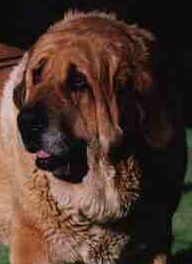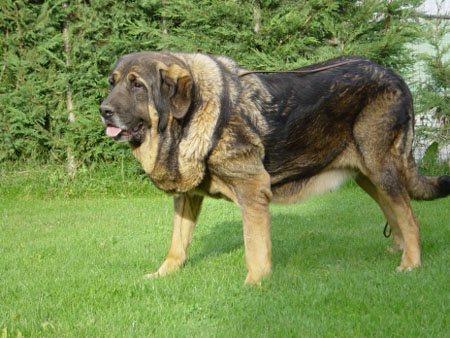PORTRAIT
The
majority of mastiffs still perform the task that marked their origin
thousands of years ago: the taming of the first ruminants and the need to
protect herds from predators.
 We
are not completely sure of the affirmed tibetan ancestry that is
constantly allocated in the cynofile literature. There is neither detailed
information that confirms it even as a hypothesis nor is it possible to
find in the same bibliography authors quote, the sources that lead them to
this conclusion. It is common that most authors restrict themselves to
repeating what others said without doing research on its real origin.
We
are not completely sure of the affirmed tibetan ancestry that is
constantly allocated in the cynofile literature. There is neither detailed
information that confirms it even as a hypothesis nor is it possible to
find in the same bibliography authors quote, the sources that lead them to
this conclusion. It is common that most authors restrict themselves to
repeating what others said without doing research on its real origin.
The
later introduction of sheep coming from the African continent in the
Iberian Peninsula could also bring forward other canine castes in the
formation of the peninsular cattle dog.
The
real history of the Mastiff begins with the establishment of "Honest
Council of the Cattle-owners' Guild " in 1273, though it is already
recognized the existence of transhumant cattle activity in times of the
Iberians.
This
legal organization of the extensive ranched cattle and the great economic
projection that is going to obtain the sector in relation to the selection
of the merino sheep is extremely important for the selection of the
Mastiff. The importance of guard dogs in herds is well reflected in the
laws that regulated The Cattle-owners' Guild and in numerous bylaws that
guaranteed from the daily nourishment up to the purity of the race, and
also in the severe fines that were imposed for the theft of a mastiff.
People used to say at that time that "one had a better rest sleeping
in a wool warehouse than that the retinue of the king could have".
These
were the excellent conditions the race kept in up to the first decades of
the XIX century: the decay of The Cattle-owners' Guild, which is
definitely abolished in 1836 and the reduction of the number of wolves,
whose populations covered at the beginning of the XX century almost the
totality of the Peninsula whereas fifty years later was cut down to the
half. Only cattle raisers from the mountains of León were worried about
this situation which would deeply affect the condition and evolution of
the race.
The
Spanish cattle dog par excellence is philogenetically
related to the rest of European and Asian races dedicated to the ancient
task of guarding and watching over the domestic cattle.
This
type of servant canine
must have been very common in Europe and Asia, or even in the north of the
African continent up to recent times, and it was often present in all
those places where the cattle, mainly sheep and goats,
had to live in the same place with its most dangerous predator, the wolf.
There
are still cattle dogs in the Caucasus and Russia, in Turkey, Afghanistan,
Iran, Mongolia, Nepal, Tibet, Tedjikistan,
Morocco, Georgia and probably in many more. In Europe, they live on at
least in Yugoslavia, Hungary, Italy, Portugal, Bulgaria, Croatia, Greece,
Romania, Slovakia and Slovenia and there must have been other castes that
took the same way as its wild ancestor, once the wolf had almost
disappeared at the beginning of the XX century and the cattle dog had
therefore done away with its raison d'être.
Mosoloid-lupin,
thick-growing hair, craniofacial divergent lines, austerity, great
physical resistance and aptitudes as guard cattle dog, are common features
in all cattle dogs all over the world. Hence, people keen on breeding
these dogs should preserve with much zeal these attributes.

MAIN
QUALITIES OF THE MASTIFF
The
capacity to resist treks of up to thirty kilometres for several days and
the short need for food are registered in the history of the transhumance.
The
maternal capacity and the fortress of the race are well depicted in a
study elaborated in 1980 (the date is important as far as the recent time
is concerned). "In normal conditions, both in the country or in
mountain passes, the female dog prepares the den digging and getting the
bed ready under any bush where she makes room for her puppies and stays
with them during their first living days". The study goes on:
"In the following days the female dog goes out with the cattle and
returns to nurse the babies and to stay with them for the night.
The
breeder must take into account the lack of these characteristics as it can
be a reason to take those affected examples out of the breeding program.
"Modern breeders" should not be proud of the number of
artificial inseminations they make and their ability to breed puppies with
baby bottles.
The
obsession in the selection of concrete features (enormous skins, flat
craniums, parallel craniofacial lines, exceeded thorax, too short snouts
and the systematical elimination of others (the rich chromatic variety for
example) can unnecessarily turn a functional race into a memory of the
past. The breeding trend directed to obtain more excessive and massive
specimens or with more wrinkles that dignity is not making healthier,
useful and beautiful mastiffs but much on the contrary.

International
zootechnical
authorities are starting to check the selective breeding in those cases
where the proper fortress and morphology of the race are not respected.
The
ability to guard the Cattle stands out among the qualities of the Mastiff
and it has been developed by stock breeders along the centuries. It is
surprising even among the connoisseurs of the race the link mastiffs
manage to create with the herd. They protect sheep having just given birth
or small herds lost in the mountain until they are found or even come back
from the comfort of the sheepfold in full night to look for them. We also
find mastiffs very often in foreign herds or looking for the herd they
unwillingly left.
Some
of them with exagerated zeal do not allow the approach of other examples
of the same race in the flock. Even the owner can have conflicts with the
dog by hitting the animals or simply by appearing in the enclosure of the
cattle at midnight.
The
specialist in canine behaviour, D. Rafael Casado, defines this way the
functional character
of the race: "The behavioral idiosyncrasy of a specimen when it is
genetically suitable is spontaneously shown in its own environment, where
we find the desirable circumstances that develop its function. The culture
of transhumance which even established the number of necessary examples in
every flock has been a suitable frame for the selection and development of
the race".
We
find the following quote referring to the system that built up this dog
race in a recent and exhaustive publication on transhumance: (In the XVI
century) "Serranos (highlanders)" carried out for the first time
in Europe - and thus, in the world - the first genetic selection towards a
concrete aim: the delicacy of wool (…) All this in a rustic and
indefatigable race, capable of running more than 30 km a day (…) Besides,
together with the merino race also some canine races developed and
perfected themselves -mastiff from Leon-, equine, bovine (…) and porcine,
perfectly adapted to the environment in which they live.
TEXT. FELIX GARCIA